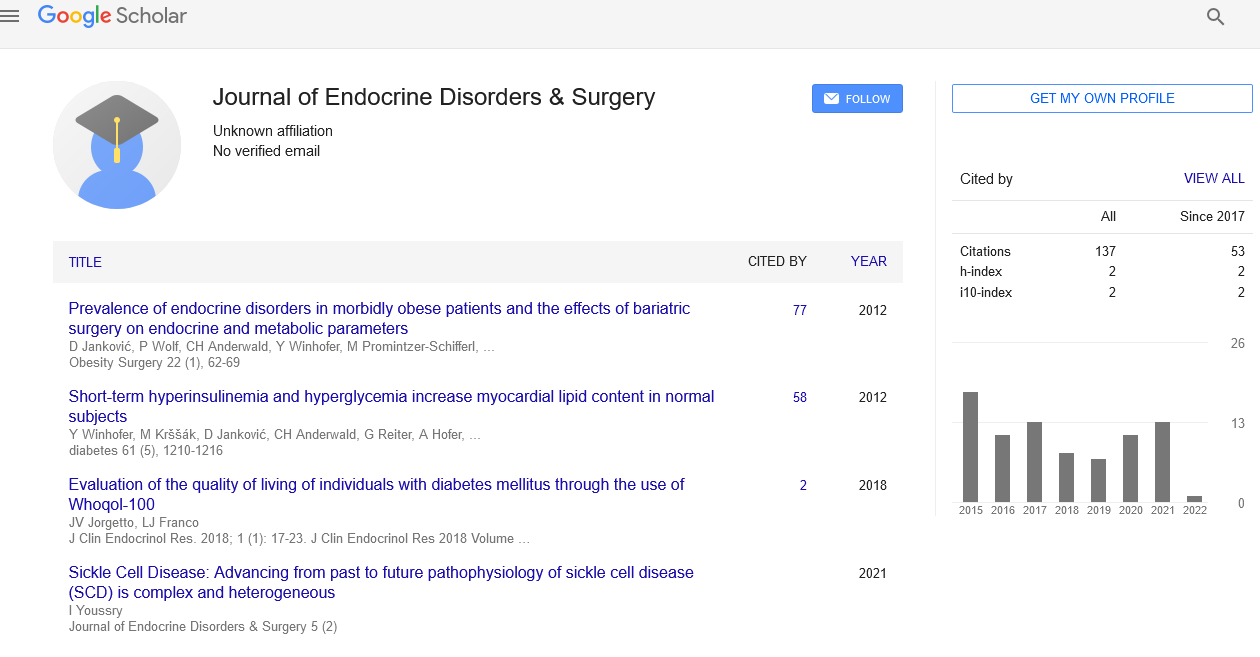Thyroxine-binding globulin
Received: 04-Dec-2022, Manuscript No. puljeds-23-6204; Editor assigned: 06-Dec-2022, Pre QC No. puljeds-23-6204 (PQ); Accepted Date: Dec 23, 2022; Reviewed: 10-Dec-2022 QC No. puljeds-23-6204 (Q); Revised: 12-Dec-2022, Manuscript No. puljeds-23-6204 (R); Published: 30-Dec-2022, DOI: 10.37532/puljeds.2022.6 (6).03
Citation: James A. Thyroxine-binding globulin. J. Endocr Disord Surg. 2022;6(6):03.
This open-access article is distributed under the terms of the Creative Commons Attribution Non-Commercial License (CC BY-NC) (http://creativecommons.org/licenses/by-nc/4.0/), which permits reuse, distribution and reproduction of the article, provided that the original work is properly cited and the reuse is restricted to noncommercial purposes. For commercial reuse, contact reprints@pulsus.com
Abstract
The SERPINA7 gene in people encodes the globulin protein known as thyroxine-binding globulin. TBG attaches circulating thyroid hormones. It is one of three transport proteins that move the thyroid hormones Thyroxine (T4) and Triodothyronine (T3) through the circulation, along with transthyretin and serum albumin. TBG, the least abundant of these three proteins compared to transthyretin and albumin, which also bind T3 and T4 in circulation, has the greatest affinity for both T4 and T3 metabolites.
Keywords
Triiodothyronine ; Thyroxine
Introduction
TBG transports the bulk of T4 in blood plasma despite its low concentration. TBG is rarely more than 25% saturated with its ligand due to the extremely low levels of T4 and T3 in the circulation. Unlike albumin and transthyretin, TBG only has one binding spot for T4/T3. TBG is mainly produced as a 54-kDa protein in the liver. TBG is a serpin according to genomics, but unlike many other serpinlike proteins, it has no inhibitory activity. Testing for thyroxinebinding globulin can help determine why thyroid hormone levels are high or insufficient. This is accomplished by quantifying the amount of labelled thyroid hormone that resin binds to, which only occurs when the labelled thyroid hormone is free. However, it may result in mistakes when interpreting thyroid hormone lab results, which may eventually result in ineffective treatment. The aetiology, diagnosis, and treatment of thyroxine-binding globulin deficiency are discussed in this paper. The liver produces Thyroxine-Binding Globulin (TBG), a serine protease inhibitor. Because the gene that makes this protein is located on the long arm of the X chromosome, inherited variants of TBG frequently exhibit an X-linked pattern. To date, it has been determined that about 27 different mutations are responsible for the inherited type of complete TBG deficiency. These changes appear to result from either a frameshift or a nucleotide substation
The only sort of mutations associated with an inherited form of partial TBG deficiency has thus far been missense mutations. The high-affinity blood binding protein and triiodothyronine is known as thyroxine binding globulin (TBG). In order to keep a constant level of free hormone, which is crucial for metabolism, the thyroid typically responds to changes in TBG concentration by producing more or less thyroid hormone. Oral contraceptives, estrogen treatment, genetic predisposition, pregnancy, and other factors are linked to elevated TBG levels. With use of androgenic or anabolic steroids, high glucocorticoid doses, hypoproteinemia conditions, liver illness, nephrotic syndrome, and congenital TBG variants, TBG levels can drop.
A protein called thyroxine-binding globulin transports hormones produced or utilised by the thyroid gland, a butterfly-shaped structure in the lower neck. The rate of chemical reactions in the body as well as growth and mental development are significantly regulated by thyroid hormones (metabolism). The majority of the time, these hormones travels through the circulation bound to proteins like thyroxine-binding globulin. Thyroxine-binding globulin deficiency reduces the quantity of thyroid hormones that are circulated addressed by a reproductive endocrinologist.
Mutations in the SERPINA7 locus cause thyroxine-binding globulin deficiency, which is inherited. Thyroxine-binding globulin is made according to directions from this gene. TBG-CD is brought on by certain abnormalities in the SERPINA7 gene that stop the synthesis of a useful protein. TBG-PD is the product of additional mutations that decrease the amount of this protein or change its structure. There are also non-inherited forms of thyroxine-binding globulin deficiency that are more prevalent than the inherited variety, according to research. A number of diseases and some medications can cause non-inherited thyroxine-binding globulin deficiency, which also happens to be a side effect.
n instances of hypothyroidism or hyperthyroidism caused by actual thyroid gland dysfunction, TBG levels don't mean much. However, they do become even more crucial if you have abnormal T3 or T4 numbers but no signs of thyroid dysregulation.
For instance, a high TBG quantity causes the TBG to bind to more thyroid hormone, reducing the amount of free hormone circulating in the blood. As a result, the body produces more thyroid-stimulating hormone, which in turn increases thyroid hormone output. Thus, even though the individual does not have hyperthyroidism, the level of total thyroid hormone will be elevated.





